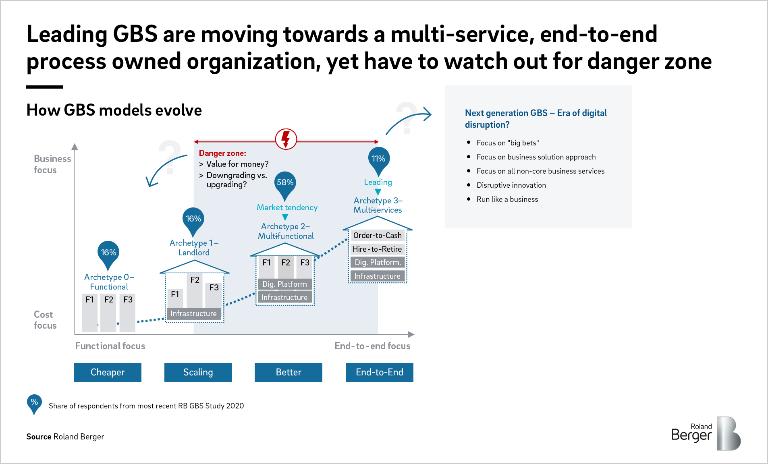

Global Business Services: Obsolete or more relevant than ever?
How Global Business Services can deliver value in an era of increased disruption
The events of 2020 have emphasized just how volatile and complex the world is today. In such a dynamic, fast-changing environment, the role – and relevance – of Global Business Services (GBS) in international organizations may be unclear. This throws up several critical questions. Is GBS becoming obsolete or is it actually now more important than ever? And, if GBS is to thrive, how can it provide value to stakeholders across an organization?

"Customer centricity is an absolute necessity for GBS organizations to truly generate value."
All about the money?
A natural evolution of the shared services model, Global Business Services combines administrative functions in hubs throughout an organization. GBS typically incorporates functions like Finance, HR and IT. Increasingly, that scope is expanding to include areas such as Procurement, Customer Service, Sales and Marketing, and Legal.
As a legacy of the shared services approach, some GBS models remain rigidly siloed: they focus with laser-like precision on the cost-efficient delivery of transactional services via standalone platforms and tools – and little else. But GBS can, and should, go beyond purely monetary savings.
Consolidating shared services into a single, structured organization that focuses on end-to-end processes can bring multiple benefits to a business, from improved efficiency and flexibility to more transparent governance. Crucially, it can also act as a platform for future growth and drive digital transformation through standardization.
Stuck in the danger zone
However, the journey from functional, cost-driven GBS to a multi-service, end-to-end approach is paved with difficulty. Today, many organizations find themselves stuck in the middle – a no-man’s land in which GBS delivers neither the desired cost nor quality benefits.
That leaves management with a choice: Downgrade and settle for focusing solely on savings? Or upgrade to a GBS model that will deliver added value across the business in an era of increased disruption?
How to move GBS up the value chain
To obtain greater insight into the present and future roles of GBS organizations, Roland Berger surveyed 20 large European companies in July and August 2020. We have combined these results with our experiences from daily interactions with clients to create key recommendations as to how GBS can drive shareholder value. To move GBS up the value chain, an organization must have a clear vision of its end goal and build a roadmap, taking into account its readiness for change and capacity to deliver. The following five areas are key on that journey.
- Prioritize customer value
Our survey shows the majority of companies regularly measure customer satisfaction via pre-defined metrics. Customer relationship management, however, is less structured: just 44% of respondents reported a dedicated CRM setup with a single point of contact. With customers prioritizing the timeliness of response and reaction to business requests (behind only the cost of services), GBS must ensure it stays in close contact to offer value. - Establish strong common services
GBS is all about sharing good practices, tools and infrastructure across functions. An organization must shift its focus from improving delivery operations to a more balanced approach that embeds customer alignment, improved governance and higher-value delivery operations. - Create multi-service, end-to-end solutions
GBS organizations now have clear alternatives to increasingly outdated solutions: focusing on value-added services instead of the cost-efficient delivery of transactional ones; a standardized service portfolio versus one driven by functions; integrated end-to-end architecture over standalone platforms and tools; and digital means of engagement over traditional ones. - Run GBS like a business
Organizations that run GBS like a business can improve annual productivity by more than 15%. Like businesses, GBS units must also decide whether to pass savings on to the business or re-invest them to improve further. Based on our experience in the field, approximately two thirds of these savings are channeled into lower costs, with 10-15% invested in talent development, technology, process improvements. - Embrace digital innovation
Key technologies can drive GBS efficiency and effectiveness. These include process mining to translate process data into actionable information; data visualization to better understand trends, patterns and outliers; and automation to deliver standardized processes more quickly, cheaply and reliably.
GBS: Done correctly, it’s more relevant than ever
According to our recent survey, 58% of organizations find themselves in the danger zone of uncertainty – caught between a functional, cost-driven focus and a multi-service, future-ready model. Successfully transitioning from one to the other requires GBS leaders who can disrupt and evolve as skillsets change. By embracing an enabling culture and service-excellence mindset, GBS can remain relevant and make a significant contribution to company success.






